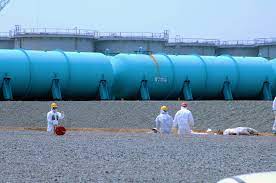IAEA Confirms 14th Release of Fukushima ALPS-Treated Water Well Below Safety Limits
As part of its ongoing multi-year safety review, the IAEA collected and analyzed onsite samples of the diluted water prior to its release.

The International Atomic Energy Agency (IAEA) has reaffirmed the safety of Japan’s ongoing release of treated water from the Fukushima Daiichi Nuclear Power Station (FDNPS), operated by Tokyo Electric Power Company (TEPCO). Independent sampling and analysis conducted by IAEA experts confirmed that the tritium concentration in the 14th batch of ALPS-treated water, discharged today, is far below both Japan’s operational limit and internationally accepted safety thresholds.
Confirmation Through Independent Sampling
As part of its ongoing multi-year safety review, the IAEA collected and analyzed onsite samples of the diluted water prior to its release. Test results showed tritium levels significantly below the operational limit of 1,500 becquerels per litre (Bq/L), a threshold set by Japanese authorities to ensure public and environmental safety. The findings align with international standards, underscoring the consistency and reliability of Japan’s monitoring process.
Decades-Long Controlled Discharge
Japan began the controlled release of Advanced Liquid Processing System (ALPS)-treated water in August 2023, with the process expected to span several decades. Before release, the treated water—stored onsite after being used in cooling damaged reactor cores—is diluted with seawater to further reduce tritium concentration. According to TEPCO’s operational data, approximately 101,000 cubic meters of treated water have already been discharged across 13 previous batches. Each batch was independently verified by the IAEA to be well within safety limits.
Safety Findings Backed by Comprehensive Review
The IAEA’s confirmation comes after its landmark safety review published on 4 July 2023, which concluded that Japan’s discharge plan is consistent with global safety standards. That report, compiled after months of technical assessments and consultations with independent experts, determined that the planned releases would have a negligible radiological impact on people and the environment.
International Oversight and Transparency
Japan’s decision to involve the IAEA in continuous verification reflects an effort to maintain transparency and build international confidence. Independent sampling, coupled with public reporting, aims to address both domestic and global concerns about the environmental and health implications of the Fukushima water release.
The ongoing oversight will continue throughout the discharge schedule, ensuring that each batch is tested and confirmed safe before entering the Pacific Ocean. This long-term monitoring framework is expected to provide assurance that Japan’s strategy for managing the treated water remains within both national and international safety parameters.










